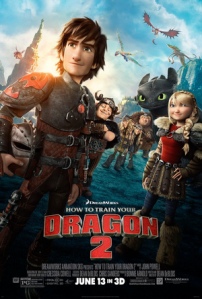Animators have it rough. The amount of detail that goes into every frame of a modern animated film is astonishing, absolutely amazing. Often times that detail only exists for seconds, if that. With the misconception that animated films with low MPAA ratings are mostly for children, that level of detail can be lost. I’ll be the first to admit, I often times overlook animated films when deciding what to pay money to see in theaters. While on vacation, I went to a local discount theater and caught a showing of how To Train Your Dragon 2 and coincidentally watched one of my favorite movies of the year.
I need to rewatch How To Train your Dragon because when I rented it I wasn’t blown away. I know this franchise is loved by many, and it’s even revered above certain Pixar offerings. It was fun, but something that I was ok just watching once and calling it good. Not so with the sequel. How To Train Your Dragon 2 shows the inhabitants of Berk in a whole new light. Their entire society now revolves around dragons rather than fears them. Hiccup is reluctantly being primed to take over responsibility as the new chieftain, when he discovers a group of dragon catchers that are supplying a mad man with forces for his army of dragons that will be used as weapons to conquer the world. You can guess what the remainder of the film is about from there.
First off, the movie looks incredible. I don’t think I’ve had a movie appeal to my primal sense of adventure this way in years. The scenes of Toothless and hiccup flying over pristine landscapes, crystal oceans and through open sky were all it took to get me caught up in the movie. Add to that a heavy dose of accurate emotional weight and a hefty dose of dragons and you’ve got HTTYD2. Everything about the movie looked like familiar in the sense that we’ve been seeing dragons on film for decades, but it built on the uniqueness of the first film in just how different someone could interpret the beasts. It was fun just seeing how many variations of the fire breathing reptiles the animators could present. The environment only added to the aesthetic appeal and sense of adventure. Berk is a fairly wild city, but it pales in comparison to the harshness beyond it’s borders.
While a movie can be pretty to look at, if it falls flat it the story telling or in the character department then you’ve got a major problem. Fortunately this was not the case. Dreamworks hit a homerun with how they advanced their characters. We’re not dealing with the same set of problems or issues already dealt with in the first film, we’re dealing with new challenges, harder ones that carry more consequences and change the franchise in bolder ways than I anticipated. It was more than I had anticipated, and I found myself far more emotionally involved with the humans and dragons alike.
How To Train Your Dragon 2 manages to take the audience on a ride to another world filled with adventure, danger and unexpected beauty. The characters are flawed and believable, it packs an emotional wallop while still being appropriate and entertaining for a young audience. Despite the many offerings this year, I would rank this among the top in terms of just sheer fun adventure. Also, Toothless is still adorable.



